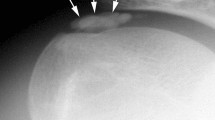Abstract
Background: Rotator cuff pathology occurs commonly and its cause is likely multifocal in origin. The development and progression of rotator cuff injury, especially in relation to extrinsic shoulder compression, remain unclear. Traditionally, certain acromial morphologies have been thought to contribute to rotator cuff injury by physically decreasing the subacromial space. The relationship between subacromial space volume and rotator cuff tears (RCT) has, however, never been experimentally confirmed. In this study, we retrospectively compared a control patient population to patients with partial or complete RCTs in an attempt to quantify the relationship between subacromial volume and tear type.
Materials and Methods: We retrospectively identified a total of 46 eligible patients who each had shoulder magnetic resonance imaging (MRI) performed from January to December of 2008. These patients were stratified into control, partial RCT, and full-thickness RCT groups. Subacromial volume was estimated for each patient by averaging five sequential MRI measurements of subacromial cross-sectional areas. These volumes were compared between control and experimental groups using the Student’s t-test.
Results: With the numbers available, there was no statistically significant difference in subacromial volume measured between: the control group and patients diagnosed partial RCT (P > 0.339), the control group and patients with complete RCTs (P > 0.431).
Conclusion: We conclude that subacromial volumes cannot be reliably used to predict RCT type.
Similar content being viewed by others
References
Via A, De Cupis M, Spoliti M, Olivia F. Clinical and biological aspects of rotator cuff tears. Muscles Ligaments Tendons J. 2013;3:70–9.
Bigliani LU, Morrison DS, April EW. The morphology of the acromion and its relationship to rotator cuff tears. Orthop Trans 1986;10:216.
Toivonen DA, Tuite MJ, Orwin JF. Acromial structure and tears of the rotator cuff. J Shoulder Elbow Surg 1995;4:376–83.
Tuite MJ, Toivonen DA, Orwin JF, Wright DH. Acromial angle on radiographs of the shoulder: correlation with the impingement syndrome and rotator cuff tears. AJR Am J Roentgenol 1995;165:609–13.
Jobe F, Kvitne R, Giangarra C. Shoulder pain in the overhead or throwing athlete. The relationship of anterior instability and rotator cuff impingement. Orthop Rev. 1989;18:963–75.
Gerber C, Hersche O, Farron A. Isolated rupture of the subscapularis tendon. J Bone Joint Surg Am. 1996;78:1015–1023. doi: 10.1016/S1058-2746(96)80434-4.
Moses DA, Chang EY, Schweitzer ME. The scapuloacromial angle: A 3D analysis of acromial slope and its relationship with shoulder impingement. J Magn Reson Imaging 2006;24:1371–7.
Stehle J, Moore SM, Alaseirlis DA, Debski RE, McMahon PJ. Acromial morphology: Effects of suboptimal radiographs. J Shoulder Elbow Surg 2007;16:135–42.
Hamid N, Omid R, Yamaguchi K, Steger-May K, Stobbs G, Keener JD. Relationship of radiographic acromial characteristics and rotator cuff disease: a prospective investigation of clinical, radiographic, and sonographic findings. J Shoulder Elbow Surg 2012;21:1289–98.
Hirano M, Ide J, Takagi K. Acromial shapes and extension of rotator cuff tears: magnetic resonance imaging evaluation. J Shoulder Elbow Surg 2002;11:576–8.
Pearsall AW 4th, Bonsell S, Heitman RJ, Helms CA, Osbahr D, Speer KP. Radiographic findings associated with symptomatic rotator cuff tears. J Shoulder Elbow Surg 2003;12:122–7.
Worland RL, Lee D, Orozco CG, SozaRex F, Keenan J. Correlation of age, acromial morphology, and rotator cuff tear pathology diagnosed by ultrasound in asymptomatic patients. J South Orthop Assoc 2003;12:23–6.
Gartsman GM. Arthroscopic acromioplasty for lesions of the rotator cuff. J Bone Joint Surg Am 1990;72:169–80.
Gartsman GM, O’connor DP. Arthroscopic rotator cuff repair with and without arthroscopic subacromial decompression: a prospective, randomized study of one-year outcomes. J Shoulder Elbow Surg 2004;13:424–6.
Goldberg BA, Lippitt SB, Matsen FA 3rd. Improvement in comfort and function after cuff repair without acromioplasty. Clin Orthop Relat Res 2001;390:142–50.
McCallister WV, Parsons IM, Titelman RM, Matsen FA 3rd. Open rotator cuff repair without acromioplasty. J Bone Joint Surg Am 2005;87:1278–83.
McCarty E Acromioplasty does not improve functional outcomes in patients undergoing rotator cuff repairs. J Bone Joint Surg Am 2012;94;1–3.
Flatow EL, Soslowsky LJ, Ticker JB, Pawluk RJ, Hepler M, Ark J, et al. Excursion of the rotator cuff under the acromion. Patterns of subacromial contact. Am J Sports Med 1994;22:779–88.
Matsen FA III, Arntz CT, Lippitt SB. Rotator cuff. In: Rockwood CA Jr, Matsen FA III, editors. The Shoulder. Vol. 2. Philadelphia: WB Saunders Company; 1998. p. 755–839.
Milgrom C, Schaffler M, Gilbert S, van Holsbeeck M. Rotator-cuff changes in asymptomatic adults. The effect of age, hand dominance and gender. J Bone Joint Surg Br 1995;77:296–8.
Uhthoff HK, Sarkar K. The effect of aging on the soft tissues of the shoulder. In: Matsen FA III, Fu FH, Hawkins RJ, editors. The Shoulder: A Balance of Mobility and Stability. Rosemont: American Academy of Orthopaedic Surgeons; 1993. p. 269–78.
Lohr JF, Uhthoff HK. The microvascular pattern of the supraspinatus tendon. Clin Orthop Relat Res 1990;254 35–8.
Huang CY, Wang VM, Pawluk RJ, Bucchieri JS, Levine WN, Bigliani LU, et al. Inhomogeneous mechanical behavior of the human supraspinatus tendon under uniaxial loading. J Orthop Res 2005;23:924–30.
Chang EY, Moses DA, Babb JS, Schweitzer ME. Shoulder impingement: Objective 3D shape analysis of acromial morphologic features. Radiology 2006;239:497–505.
Meskers CG, van der Helm FC, Rozing PM. The size of the supraspinatus outlet during elevation of the arm in the frontal and sagittal plane: A 3-D model study. Clin Biomech (Bristol, Avon) 2002;17:257–66.
Author information
Authors and Affiliations
Corresponding author
Rights and permissions
About this article
Cite this article
Yi, A., Avramis, I.A., Argintar, E.H. et al. Subacromial volume and rotator cuff tears. IJOO 49, 300–303 (2015). https://doi.org/10.4103/0019-5413.156201
Published:
Issue Date:
DOI: https://doi.org/10.4103/0019-5413.156201




